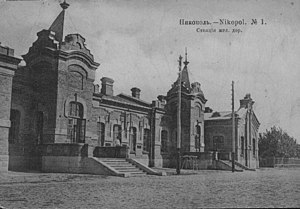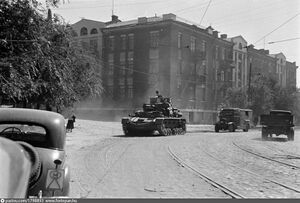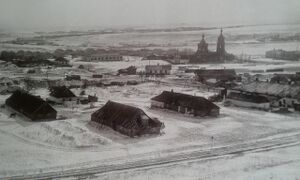30. Januar 1944
| GEO & MIL INFO | ||||
|---|---|---|---|---|
| Nikopol | ||||
| Kriwoi Rog | ||||
| Position near Wesselyi Kut | ||||
| LVII. Pz.K.[1] | ||||
| GC: Gen d PzTr von EsebeckWP
CoS: O LaegelerWP |
||||

At Nikopol station there are three elongated, single-storey brick buildings where our companies spend the night. The next morning I start to prepare for loading and enter the station concourse. My gaze falls on a large poster on the wall: "On .. .. were shot because after returning from holiday they stayed in Nikopol for a day without permission ... signed: Schörner." That's a clear warning. Typical Schörner. Hopefully, when he stands before the Lord God, Schörner will be able to justify all the shootings he has ordered. (Note: Schörner was put on trial after the war. They were only able to prove one legally contestable shooting against him.)[3].
The wagons have arrived. The companies fall in between the houses. It is quite a beautiful picture when you see these martial figures with steel helmet and rifle standing in rank and file. Helmet to helmet they stand there, the soldiers of my company, my upright comrades. What have we not endured together in heat and frost, rain and snow, hunger and thirst, dust and piercing wind, drumfire and tank battles, assaults and fierce defences, sleepless nights in front of the enemy. And we endured it all, silently or cursing, acquiescing and grimly.
The columns were lined up at greater intervals near the ramp, a group of men next to each vehicle. The vehicles roll smoothly onto the wagons, are wedged and lashed down. The men quickly stow their equipment and luggage. In 45 minutes, the entire battalion is loaded and ready for departure.


Kriwoi Rog! The column of the battalion marches through the cobbled streets of the city. Some of them had tram tracks. Then we veer off and march along the outskirts of the city. The terrain rises and now we can see the town lying somewhat below us. The installations of the ore mines and the rust-red heaps of ferrous rock rise above the residential buildings. Krivoy Rog is the most important iron ore region in European Russia.
We march past a clearing station housed in a former school. Next to the building is a cemetery. I see many fresh graves. This sight brings me back to reality. The many geographically interesting impressions made me forget the war for a moment.
We stop on the heights outside the city. Here on the outskirts of the city, the paths are sandy and unpaved again and the houses are small and rustic. A car is already waiting for us to drive the marshallers ahead. We are to take up new positions near Losowatka, a place north of Kriwoi Rog.[4]
My bunker is near the battalion command post. It's low and a bit cramped, but warm. When I get up from my cot, I bump into the small table that stands on a pillar close to the edge of the bed. As it's a bit dark in the corner, I've attached my mirror to the support beam so that it reflects the light from the small window onto the table.
The regimental commander phones to ask if my devices are all in order. I told him that I had sent one set back to the train because I could manage with the others. The set wasn't working properly. Haarhaus is taken aback and starts to reproach me. After talking back and forth for a while, he says: "Well, Schrödter, I don't understand you. Speak without a cover names!" And it turns out that by "set" he meant my mortars, while I had my field telephone in mind. But he still doesn't trust me and orders me to make another verbal report about my readiness for action. Furious, I set off in the middle of the night to find my positions in the black darkness. My four mortar positions (I only have four mortars left, actually there should be six[5]) are all located near the battalion command post, where the regimental commander also currently occupies a bunker.[6] The firing positions are all in order. The platoon leader is connected to my company command post by a cable. He also has another cable to one of the four firing positions. The others are connected by a paging line, which ensures communication. After I have checked everything once again and the platoon leader, Sergeant Grodzicki, repeatedly assures me that everything is ready for action, I go to the regimental commander's bunker to make my implementation report. But the high gentleman is not available. A sergeant takes the report.
It is well known that in telephone communications near the front, code names were used to conceal the type of weapons, command structure, etc. Sensically, the rank was taken into account when choosing the names (which should have been avoided!). The commander was the "eagle", the little company commander the "mudlark" (names chosen at random). The mudlark is then panned by the commander and replies: "Yes, Herr Eagle! At your command, Herr Eagle!" Great camouflage, eh?[7]
Haarhaus has been my regimental commander since the beginning of the Russian campaign, but our relationship has always been very impersonal. I never really found an explanation for his wooden demeanour. The few conversations we had were always short and dry. Was he cold, haughty, arrogant, unsociable, awkward, uptight? I don't know.[8] Perhaps it was simply because he didn't like my temperament. I'm pretty sure he didn't like me particularly. It's striking how quickly my promotion and other war decorations followed one another since I was - later - no longer subordinate to Haarhaus.
|
Editorial 1938 1939 1940 1941 1942 1943 1944 1945 1946 1947 1948 1949 Epilog Anhang |
|
January February March April May June July August September October November December Eine Art Bilanz Gedankensplitter und Betrachtungen Personen Orte Abkürzungen Stichwort-Index Organigramme Literatur Galerie:Fotos,Karten,Dokumente |
|
1. 2. 3. 4. 5. 6. 7. 8. 9. 10. 11. 12. 13. 14. 15. 16. 17. 18. 19. 20. 21. 22. 23. 24. 25. 26. 27. 28. 29. 30. 31. Erfahrungen i.d.Gefangenschaft Bemerkungen z.russ.Mentalität Träume i.d.Gefangenschaft Personen-Index Namen,Anschriften Personal I.R.477 1940–44 Übersichtskarte (Orte,Wege) Orts-Index Vormarsch-Weg Codenamen der Operationen im Sommer 1942 Mil.Rangordnung 257.Inf.Div. MG-Komp.eines Inf.Batl. Kgf.-Lagerorganisation Kriegstagebücher Allgemeines Zu einzelnen Zeitabschnitten Linkliste Rotkreuzkarte Originalmanuskript Briefe von Kompanie-Angehörigen |
- ↑ On 30 Jan 44 there was already, at Corps HQ, a „meeting with First Lt. Strahl, Div.Mot.Offr.257.Jnf.Div., about motor vehicle situation of the division. The div. has a lot of damaged vehicles.“ (KTB LVII. Pz.K., NARA T-314 Roll 1495 Frame 000220) Maybe the subordination only changed with transfer of authority in the division's new sector on 31st at 3 a.m. (KTB 6.A., NARA T-312 Roll 1492 Frame 000480).
- ↑ Ст. Никополь
- ↑ He is said to have always had his military judge with him
- ↑ In the evening of 30 January 1944, III./477 takes over its new section, on the 31st at 3 o'clock 257th I.D. takes over its entire section (KTB AOK 6, NARA T-312 Roll 1492 Frame 000480); II./G.R.477, G.R.466 (000176) and II./A.R.257 are still missing
- ↑ As of 1 Feb 44, 257th I.D. reported 6 mortars m.Gr.W.34 in his company (KTB AOK 6, NARA T-312 Roll 1483 Frame 000375). In the previous month, the total shortfall was greater (KTB AOK 6, NARA T-312 Roll 1484 Frame 000532), but there are no figures for the individual companies.
- ↑ The regiment only had the III Battalion at this time. The II Battalion was with the 387th I.D. in the bridgehead, and there was no I Battalion at that time.
- ↑ The editor has seen several such lists of cover names and cannot confirm this recount.
- ↑ His son Peter Haarhaus always had the impression "that he shut himself off because he hated the many losses of human life. [...] Perhaps he didn't want to lose people with whom he would have become closer friends." (Letter dated 16 November 1995)

